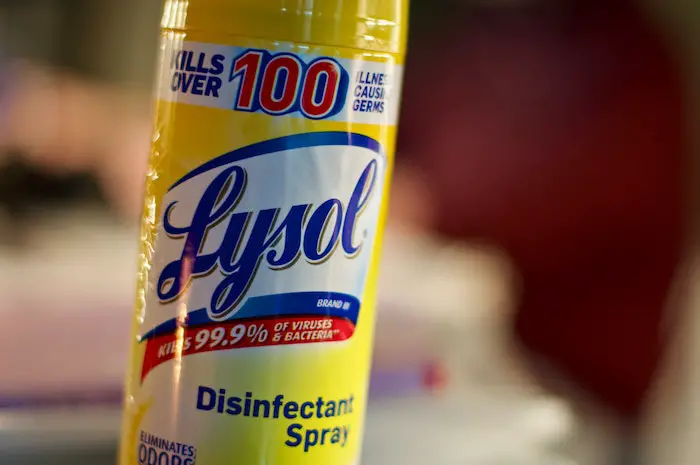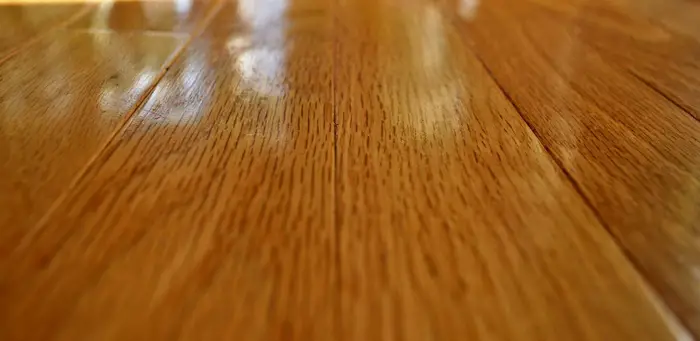Sometimes after using a lot of Lysol, there’s a strong chemical smell left infiltrating the entire area. Depending on where it was sprayed, it may also seem to stick to surfaces long after it was initially sprayed or used to wipe an area down. If you or someone else sprayed far more than necessary into your car’s vents or managed to drench your living room carpet, the intense chemical smell can bring on feelings of nausea or even a headache.
Using vinegar or baking soda are two of the best ways to neutralize the strong odor of Lysol. If the smell of vinegar is bothersome, you can add a little bit of an essential oil like lemon, orange, grapefruit, rosemary, peppermint, or cinnamon. However, baking soda is well known for its ability to neutralize odors in any setting, hence many people even store an open container in their refrigerator to keep their kitchen smelling fresh.
Quick How-To Overview
- Using White Vinegar with Essential Oils
- How to Mix White Vinegar for Use on Various Surfaces + Using Baking Soda for Fabrics
- Other Things You Can Add to Give It More Odor-Removing Power
- What to Do When All Else Fails
Using White Vinegar with Essential Oils
One of the best ways to neutralize the strong odor left behind by Lysol is with plain, white vinegar. You can blend it with your favorite essential oil, but lighter-scented oils will not cover up the Lysol scent as well as stronger ones. It’s advised to avoid using any of the lighter scented oils like rose, lavender, chamomile, or evening primrose. However, some the following essential oils listed work well mixed with vinegar to remove the smells you dislike:
- Peppermint
- Cinnamon
- Orange
- Grapefruit
- Lemon
- Rosemary
- Tea Tree
- Eucalyptus
- Bergamot
- Mandarin
- Lime
- Clementine
- Helichrysum
- Sweet Basil
How Do You Mix Vinegar and Essential Oils to Get Rid of Lysol Odor on Various Surfaces?
Different surfaces will require different types of cleaning methods when it comes to your scented vinegar. Additionally, the surface area will come into the equation as well.
If you’re trying to get the smell of Lysol off of your hands, fill a bowl with vinegar and add about 10 to 20 drops of essential oil. Mix well with your fingers and then let your hands rest in the mixture for a few minutes to soak. Remove your hands from the bowl and wash them with warm water and soap, drying them off and smelling them afterward to check for how effective your mixture was. If the Lysol scent remains, repeat the process.
For hard, non-porous surfaces like those in your kitchen, you can simply spray the vinegar and essential oil mixture onto those surfaces and allow it to sit for a few minutes without drying. Wipe down the counters and other surfaces with an absorbent, dry cloth to clean everything up, and you should notice a significant improvement in the reduction of the Lysol smell. Repeat as many times as needed since vinegar is such a safe cleaning agent and unlikely to damage any of the surfaces in your kitchen or bathroom.
Car Vents and Carpeting

If you’re looking to get the smell of Lysol out of something like the vents in your car, the carpet in your living room, or the fabric of your mattress, you’ll need to clean these by using a spray bottle with vinegar. Add around 20 to 30 drops of your preferred essential oils, and shake it up well. You could even add some rubbing alcohol if you think it’s really bad.
For fabrics and soft surfaces, spray this mixture generously onto the surface in question. If the problematic surface is in your car, turn the car on along with the air conditioning running, all vents open, and the windows down. It is recommended to leave the vehicle like this for a considerable period of time—anywhere from 20 to 45 minutes.
If this is your living room carpet, open the windows and turn on a fan once you’ve sprayed the mixture to help the air circulate and remove the smell as the vinegar and essential oil mixture works its magic.
As for using baking soda in these instances, no mixing of ingredients is necessary. You can simply sprinkle baking soda powder onto your carpet, rugs, interior of your vehicle, or any other soft surfaces (furniture included) and allow it to sit for as long as possible. Take the time to go complete a few chores or make an important phone call, then use a vacuum to suck up an excess powder on these fabrics. Afterward, you should notice a significant improvement in how well the baking soda removed the Lysol scent (as well as any other odors) from the soft surfaces of your home and vehicle.
Use the Power of the Sun
Any type of cleaning is a good idea when it’s warm and sunny outside because the sun will naturally mitigate any smells. When used in combination with vinegar mixtures for cleaning, natural sunlight and a dry, heated environment work like a charm to get rid of unpleasant odors and smells.
Can You Add Other Things to Vinegar to Remove Lysol Odor?

You don’t have to relegate yourself to mixing vinegar solely with essential oils. There are a few other things you can add to your vinegar to help remove Lysol odors and improve the smell of your home, vehicle, and belongings. Here are a few other options depending on your preferences as well as what you may have available in your home at the time of cleaning:
- Rubbing Alcohol (a tablespoon or two)
- Borax
- Water (this will dilute the strength of the vinegar)
- Hydrosols (the water left over after making essential oils for an additional scent)
- Coconut Oil (famous for getting rid of anything, add a teaspoon to ½ tablespoon but melt it first)
- Espresso or Strong Coffee (coffee can eat away any smell; use a tablespoon or two of black coffee – no cream or sugar)
- Lemon Juice (squeeze fresh lemon into the vinegar)
However, be sure to always check reliable sources of information before mixing any household or cleaning ingredients to avoid significant dangers. Even mixing something as gentle as hydrogen peroxide with vinegar will immediately cause a chemical reaction resulting in peracetic acid, which is highly corrosive and dangerous.
Additionally, mixing the two recommended scent-removing ingredients of baking soda and vinegar is not recommended for use in spray bottles nor on most surfaces. These two mixed together form a very intense chemical reaction that’s fantastic for cleaning things like clogged drains, tea pots or coffee mugs with built up residues, or other “deeper” items with stronger buildup, but the mixture is not ideal for other surfaces or purposes due to its intensity along with the impressive mess it may cause. (If you’ve ever seen a child’s science volcano project that erupts, the eruption is made by mixing baking soda and vinegar together!)
What If the Lysol Odor Remains After Several Vinegar Applications?
If you’ve tried the vinegar tricks above and using baking soda on any applicable surfaces, yet the Lysol odor is still strong, you may have to scrub whichever surfaces are still being problematic with a harsh and heavily scented cleaner. You may also need to rent an upholstery steam cleaner from your local hardware or grocery store if the Lysol usage was extreme enough to penetrate too deeply into the afflicted fabrics.
If none of these methods are successful, it might be best to hire professionals to attempt to remove the smell in the event that something significant like an entire container of Lysol was used in one concentrated area and the smell cannot be removed.
Final Thoughts
When there’s an overpowering smell of Lysol in your home or vehicle, it can be disconcerting, to say the least. Vinegar is always a good way to go—it’s safe, effective, and can work like a dream when used in combination with oils and even the sun. For soft surfaces, baking soda is a fantastic go-to that been relied on for decades.
However, if you make several attempts and you have no luck getting rid of the odor, it may be best to hire a professional cleaning service if you simply can’t remove the smell from your home.
See Also:
Can You Use Laxative Mineral Oil On Cutting Boards?
How To Remove Toilet Bowl Cleaner Stain From Countertop
Speed Queen Vs. LG Washers: A Close-Up Look
How To Clean Felt In A Jewelry Box


